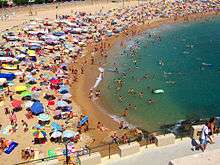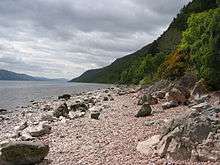Beaches
Being on a beach is an essential part of a vacation for many. Types of beaches and practices vary, as do the activities visitors come there for — mostly water sport, or for cleansing.
Understand


A beach is an area of loose sloping material (sand, rocks, gravel or pebbles) between the land and either the sea or a freshwater lake or river. The composition of the beach can often be important in deciding if it is really suitable for your use. A sand beach is usually more comfortable to sit or lie on than a pebble one.
On a seaside beach the area nearest the sea will be covered by water twice a day when the tide comes in – this means that the size of the beach can vary greatly during the day. Freshwater beaches are not affected by tides, but water levels in lakes can vary, and there may be less beach after heavy rain or at the height of the rainy season in tropic or Mediterranean (winter rain, summer dry) climates.
A useful method of identifying good beaches near your holiday destination is to look at those with a Blue Flag eco award. However this list does tend to concentrate on beaches that have developed facilities, rather than remote empty ones.
Get in
As most people come to the beaches, they are usually not too difficult to travel to. Places with extensive public transportation might even have a stop named "beach" that is as close as you can get on firm dry ground to the beach. Some beaches are reserved for patrons of a specific tourist businesses or group of tourist businesses. There are also beaches off the beaten track, free to use for anybody who wanders off enough (in countries where they are not regarded private property).
Fees and permits
Some beaches charge a fee. At other beaches – particularly those important to the breeding of certain species of turtles – you may need a permit to enter at certain times or not be allowed to enter at all despite the beach being open during other times of the year.
See
- Sunsets are almost always enjoyable when watched from the beach if the beach faces the west (and for early birds, sunrises if the beach faces the east). Note that they can be rather short in tropic and rather long in polar areas.
- Quieter beaches are often visited by seabirds. A beach can provide a good spot for birdwatching as the birds can often be more clearly seen against the background of a beach, and they are often attracted to the beach by the worms and fish to feed on.
Do
- Sunbathing
- Socializing
- Water sports
- Beachcombing
Work
Many people enjoy working as lifeguards. If you have the requisite skills and are a citizen or have a work permit in your target area, you may be able to enjoy spending your days on the beach all summer getting paid.
Another type of work allowing you to be on the beach all day is selling refreshments such as cold drinks, ice cream or snacks from a cart or a kiosk.
Of course this work tends to be highly seasonal, even in tropical countries, where beaches may be next to empty in the dry season. Pay can be good, but if you aren't from the area, accommodation will significantly diminish your income and you will be paying peak season rates, naturally.
Buy
Popular beaches attract salespersons of all kinds, but be careful as their merchandise may often be of sub-par quality or overpriced. Haggling is often practiced with this type of vendor, especially if they operate a mobile operation and don't have fixed stalls.
Eat
Some beaches have cafés or stalls selling food either on the beach or very close to it. In other cases you will have to bring everything with you, from shops a long distance away. On quieter remote beaches there may be a chance to gather wild seaweed or shellfish or to catch a fish.
Note that on some beaches (especially those which are considered private property), eating and drinking may not be permitted.
Wild food

It is important to enquire locally before gathering any wild food from a beach. Three key things to ask about are:
- What is permitted. There may be local laws which prohibit or limit what can be taken. Even if gathering is allowed, there may be limits on how much you can take, or the need to buy a permit.
- Safety. Obviously you should only eat species which are safe to eat, and only those which have been living in clean water and have a clean bill of health. Sometimes the local food safety bodies will report the results of monitoring of shellfish safety – although this may be aimed at commercial harvesting, this can still give a useful guide. Search online for local official advice, for example see this advice for New Zealand, New South Wales, United Kingdom and Ireland.
- Sustainability. Is there a big enough population of the seafood to be able to lose a little to gathering? Don't take stuff if the population is threatened or if local wildlife is in need. Always ensure that you only take a small part of what you can see.
Some shellfish like mussels can be found attached to rocks. Others like cockles can be found on the tidal part of a sandy beach, covered by an inch or three of sand.
Drink
It is important to make sure you have a sufficient water supply, whether that means using water fountains that are in some cases provided near the beach or bringing your own drinks. Do be careful, though, about alcohol: Avoid going into the water if there's any chance you may be impaired by alcohol, as that greatly increases the risks of drowning and other types of accidents. Alcohol also increases the risk of dehydration.
Sleep
Many beaches have accommodation nearby – hotels, hostels or campsites. At more popular beaches it is often significantly cheaper to find somewhere to stay a short distance back from the beach, avoiding the premium rates charged by places directly on the beach.
At more remote beaches, you may be able to wild camp near the beach. It is often best to avoid camping on the beach itself, as the site is often exposed and you may get caught out by extra high tides. Instead head a short distance inland, going beyond any dunes to avoid damaging this fragile terrain. Know local laws: in some countries the beach is a commons, while you risk committing trespass inland.
Stay safe
- See also: Water sports#Stay safe
- Big waves. So called rogue waves can emerge with little warning, up to about twice the hight of waves around. Watching a storm from the shore can be dangerous. Apart from possible falling trees or branches and flying debris, two feet of water can easily pull a person into the sea.
- Currents. Usually the safe areas are marked, but when visiting a beach in off hours or using an unofficial beach, you have to be careful.
- At ocean beaches there are often currents that can take a swimmer out to sea, caused by tides or waves (even in still weather). Areas within a mile of straits have pronounced rip currents, and may have drop-offs due to constantly changing topography.
- Undertow and strong ocean currents. Some beaches, such as many along the coast of the South China Sea that aren't partially enclosed by capes, have deadly undertow that is likely to kill you if you swim or wade out too far.
- Currents at rivers are often more obvious, but should be equally respected.
- Ships passing by can create strong (and invisible) currents. Only swim where ships are visible when it is explicitly allowed
- Quicksand, drop-offs and other seabed features; submerged trees and other obstacles. These are usually not a problem as long as you keep to the marked area and the official season.
- Dangerous wildlife, such as shark and jellyfish; also note sea urchins.
- Sunburn and sun protection — especially if you've flown from somewhere with remarkably less sun intensity than at the destination, you shouldn't spend too much time in the sun during the first couple of days.
- Near access paths for some beaches, poisonous plants like poison ivy may be growing.
- Don't get cut off from the main shore. If the tide is starting to rise, consider moving back towards known land.
- Take heed of what local tradition says about certain beaches, such local knowledge is especially useful in respect of remoter ones.
Respect
Dress code
There are nude or naturist beaches, beaches where toplessness is common and beaches with stricter requirements — some of them much stricter, such as if you go to the beach in Iran. Whether children have to follow the dress code also varies.